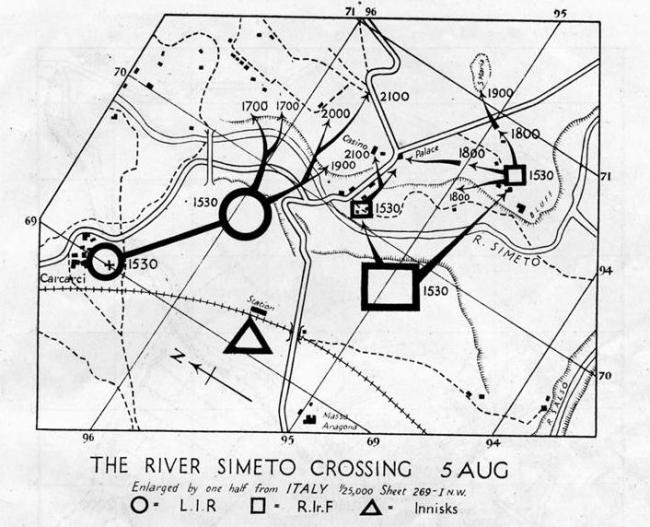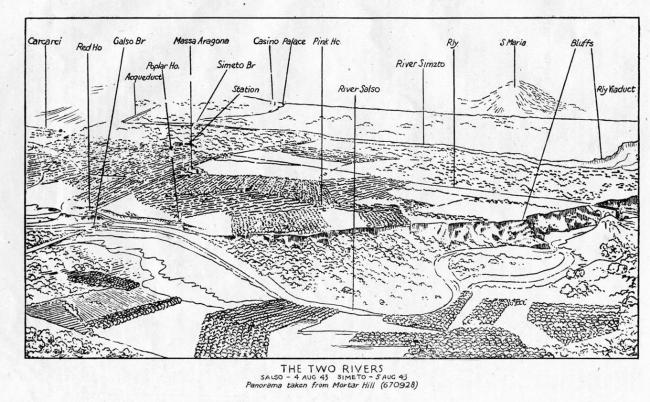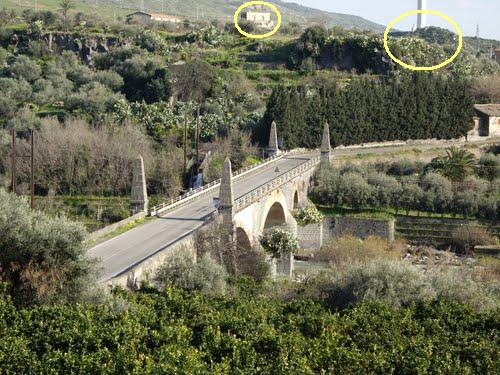
 Translate
Translate
-
* News
- - Agira 2018, 75 years later
- - Agira 2013, 70 years later
- - Gallery of ceremony 2013
- - Operation Husky 2013
- * Students' Contribute
- * About Us
- * Visitor's Book
- * Collaborators
- * Canadian Battles
- * Italian Defensive Positions
- * Allied Forces
- * Historical Movies
- Historical Information
- Historical Maps
- * Bibliography
- Biographies
- * Catania War Cemetery
- * Moro River War Cemetery
- * Syracuse War Cemetery




Adrano was a Battle Honour granted to Canadian regiments that fought near that town during the Battle of Sicily, a phase of the Italian Campaign during the Second World War. The Honour was awarded to all units that participated in the separate battles at Catenanuova, Regalbuto, Centuripe and Troina Valley.
As the US 7th Army advanced east along the northern coast of Sicily towards Messina, the 8th Army was able to resume a northward advance on the east coast. In the centre of the island, British XXX Corps was tasked to take Regalbuto, Centuripe and Adrano. The 3rd Brigade was temporarily assigned to the British 78th Division for their drive on Centuripe, and fought a successful action at Catenanuova on 29-30 July, and then at Centuripe. The Germans, having lost Regalbuto and Centuripe to their rear, quickly withdrew to avoid being encircled. By 2 August the stage was set for the advance to Adrano, where the Canadians fought several battles in the Troina Valley on the flank of the British 78th Division, who eventually took the town.

The following Canadian units were awarded the Battle Honour "Adrano" for participation in these actions:
 1st Canadian Armoured Brigade
1st Canadian Armoured Brigade
-
12th Canadian Armoured Regiment (The Three Rivers Regiment)
 1st Canadian Division
1st Canadian Division
-
4th Reconnaissance Regiment (4th Princess Louise Dragoon Guards)
-
The Saskatoon Light Infantry (MG)
 1st Canadian Infantry Brigade
1st Canadian Infantry Brigade
-
The Royal Canadian Regiment
-
The Hastings and Prince Edward Regiment
-
The 48th Highlanders of Canada
 2nd Canadian Infantry Brigade
2nd Canadian Infantry Brigade
-
The Seaforth Highlanders of Canada
-
The Loyal Edmonton Regiment
 3rd Canadian Brigade
3rd Canadian Brigade
-
Royal 22e Regiment
-
The West Nova Scotia Regiment

Original map where the military command of the 38th (Irish) Brigade drew up the crossing plan of Simeto river on August 5 1943 Two companies, the R.Ir.F (Royal Irish Fuciliers) and LIR (London Irish Rifle) forded the river to the right and left of the bridge Maccarrone, of which the retreating Germans had demolished one of the great arches while Innskilling (Royal Inniskilling Fuciliers) remained in reserve.

The following excerpt, taken from http://www.irishbrigade.co.uk, official website of the Irish Brigade, shows the exact chronology of military operations.
By 1030hrs, the plan had been readjusted where necessary and orders issued:
Right - Royal Irish Fusiliers.
Objectives - Point 225 (708748), Pink Ho, Maria (711952), The Palace (705954), and Casino (704955).
Left - London Irish Rifles.
Objectives - Hole Ho, Quarry Ho, Viaduct (707958).
Reserve - Inniskillings.
Zero - 1530hrs.

The circles indicate the German defensive positions
Attack to have full scale Divisional Artillery Support plus 4 Medium Batteries, and in addition two platoons of 4,2” mortars were in position.
Although the issue was never really in doubt, and the action concluded with one third of our infantry in hand, it was slow, hard, bitter fighting.
Enemy MG posts and snipers were hidden in caves (the whole northern cliff face was afterwards discovered to be honeycombed with caves) and each one had to be tracked down and eliminated. The Casino and Palace, both strongly built stone houses, were strong points, and every house between the river and the Y Junction (705955) had its quota of snipers.
The Casino and the Palace were the last to fall, but were finally liquidated at dusk after bombardment by the A/Tk guns of the Royal Irish Fusiliers from the right (range 800 yards), and a PIAT of the LIR from the left (range 120 yards).
Not many prisoners were taken in the operation, but a wounded sergeant major of the Herman Goering Division, who was taken in the Casino, described his afternoon as being “unpleasant”.
By 2100hrs, the bridgehead was secure, with the Royal Irish Fusiliers on the right, the London Irish Rifles on the left, and the Inniskillings on the southern bank between the river and the railway station.
The stage was again at the disposal of the Sappers, ready and able for their 24 hours job.
Twenty four hours later, the 11th and 36th Brigades passed over a Sapper miracle and the Irish Brigade rested on the banks, and bathed in the waters of a river, which they felt they’d some claim over.
It is of interest to note that from the afternoon of August 1st until the night of August 5th, the Irish Brigade had advanced 25 miles and fought the three hard fights of Centuripe, Salso and Simeto.
A tribute must be made to Sappers - everything depended on the Sappers, and they were magnificent. Recce parties under fire, bulldozing under fire, bridge building under fire, the work still went on.
The badly cratered mountain road between Catenanuova and Centuripe was fixed on the night of 2nd/3rd August.
The large crater between Centuripe and the Salso was fixed on the night of 3rd/4th August.
12 hours work completed the Salso crossing and 24 hours work completed the Simeto crossing. A layman would consider it good work in a week and a fortnight respectively.

Questa è la mappa originale dove il comando militare della 38^ (Irish) Brigade disegnò il piano di attravesamento del fiume Simeto del 5 Agosto 1943. Due compagnie, la R.Ir.F (Royal Irish Fuciliers) e la L.I.R. (London Irish Rifle) guadarono il fiume rispettivamente a destra e a sinistra delponte Maccarrone, di cui i tedeschi in ritirata avevano demolito una delle grandi arcate. Mentre gli Innskilling (Royal Inniskilling Fuciliers) restarono di riserva.

Nel seguente brano, tratto dahttp://www.irishbrigade.co.uk, sito ufficiale della Irish Brigade, è riportata l'esatta cronologia delle operazioni militari.
Il piano fu messo a punto, dove necessario e gli ordini emessi alle ore 10:30:
A destra: La Royal Irish fuciliers.
Obiettivi Punto 225 (708748), Rosa Ho [House], [Poggio] S. Maria (711952), il Palazzo (705954) e il Casalino (704955).
A sinistra: la London Irish Rifles.
Obiettivi: Foro Ho [House], Cava Ho [House], viadotto (707958 ).
In riserva: Inniskillings.
Ora zero: 15:30.
.

I cerchi indicano le postazioni difensive tedesche
L’attacco doveva avere piena disponibilità del Divisional Artillery Support più 4 Medium Batteries, e in aggiunta furono in posizione due plotoni di mortai da 4,2"
Anche se la questione non fu mai realmente in dubbio e l’azione, lenta, dura e con aspri combattimenti, si concluse con un terzo della nostra fanteria utile.
Postazioni di MG nemici e di cecchini erano nascosti nelle grotte (tutta larocca nord fu poi scoperto essere a nido d’ape con grotte) e ognuna di questedoveva essere individuata ed eliminata. Il Casalino e il Palazzo, entrambe le case costruite con pietre resistenti, erano i punti di forza, e ogni casa tra il fiume e il bivio (705955) aveva la sua quota di cecchini.
Il Casalino e il Palazzo furono gli ultimi a cadere, furono definitivamenteconquistati al tramonto dopo il bombardamento da parte dei cannoni A/Tk[Anti-Carro] della Royal Irish Fuciliers da destra (gamma 800 yards), e unPIAT della L.I.R. dalla sinsitra (range 120 metri).
Durante le operazioni furono fatti pochi prigionieri, ma un sergentemaggiore ferito, della divisione Herman Goering, catturato nel Casalino, descrisse il suo pomeriggio come “sgradevole”.
Per le 21: 00, la testa di ponte fu stabilita, con la Royal Irish Fuciliers a destra, la Royal Irish Fusiliers sulla sinistra e gli Inniskillings nella riva sud tra il fiume e la stazione ferroviaria [Carcaci].
La postazione fu di nuovo a disposizione dei genieri, pronti e capaci di lavorare 24 ore.
Ventiquattro ore più tardi, oltrepassarono la 11th e 36th Brigate in seguito al lavoro miracoloso dei Sappers [genieri] mentre quelli della Irish Brigadesi riposarono sulla riva [del Simeto] e si lavarono nelle acque del fiume, si sentivano protetti da sopra.
E’ interessante notare che dal pomeriggio del 1° agosto fino alla notte del 5 agosto, la Irish Brigade ebbe avanzato 25 miglia e combattuto i le tre dure battaglie di Centuripe, del Salso e del Simeto.
Un merito deve essere dato ai Sappers – tutto dipese dai Sappers, furono magnifici. Esplorazione dei luoghi, lavori con buldozer, costruzione di ponti sempre sotto il fuoco nemico e il lavoro ancora sarebbe continuato.
La strada di montagna con brutti crateri tra Catenanuova e Centuripe fu sistemata la notte del 2/3 agosto.
Il grande cratere tra Centuripe e il Salso fu sisemato la notte del 3/4 agosto.
In 12 ore di lavoro si completò la traversata del fiume Salso e in 24 ore la traversata Simeto. Un civile lo avrebbe considerato un buon lavoro se completato in una settimana e una quindicina di giorni, rispettivamente.



